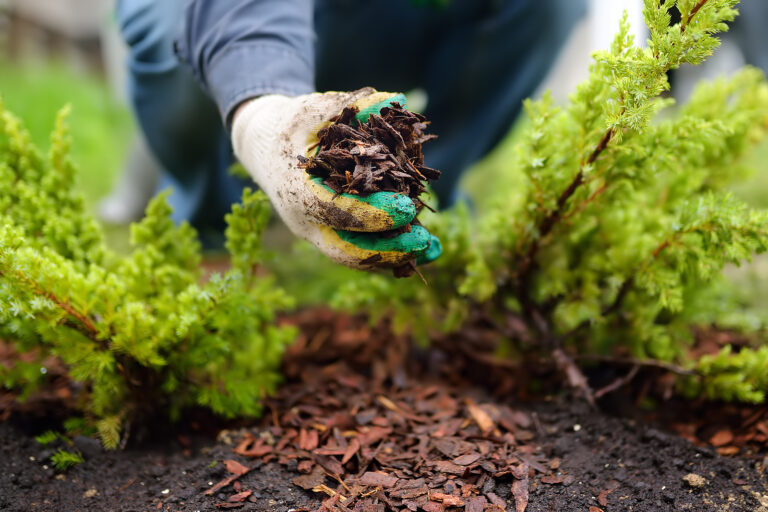Mulching for Soil Health: How to Protect and Feed the Soil Naturally
Mulch protects soil and helps it stay alive. A good mulch conserves moisture, keeps soil temperatures even, and adds organic matter that feeds earthworms and microbes. Healthy soil is living soil—and mulch is its best protection.
Why Mulch
Bare soil dries quickly, erodes, and loses fertility. A layer of mulch shades the soil, reduces evaporation, prevents crusting, and slows weed growth. As mulch breaks down, it becomes part of the soil—improving texture and increasing nutrients.
Types of Mulch
- Organic mulches: Compost, shredded leaves, straw, grass clippings, bark, and wood chips. These improve soil as they decompose.
- Inorganic mulches: Gravel, stone, or fabric. These conserve moisture but do not feed the soil.
For vegetable beds, always choose organic mulch—it adds nutrients and supports soil life.
How to Apply Mulch
- Prepare the bed: Remove weeds and water deeply before adding mulch.
- Spread evenly: Apply 2–4 inches of mulch; keep it 1–2 inches away from plant stems.
- Renew as needed: Add a fresh layer once or twice a year as mulch breaks down.
Best Mulches for the Garden
- Vegetable beds: Straw, compost, or shredded leaves—easy to move and rich in nutrients.
- Perennial beds: Bark or wood chips—long-lasting and good for weed control.
- Garden paths: Coarse wood chips or gravel—durable and slow to compact.
Seasonal Mulching
- Spring: Wait until soil warms before applying mulch.
- Summer: Maintain a thick layer to hold moisture and cool the soil.
- Fall: Add mulch after cleanup to protect soil through winter.
Long-Term Benefits
Mulching builds soil health naturally. Over time, you’ll see darker, looser soil, fewer weeds, and better moisture retention. Plants grow stronger, roots reach deeper, and the garden becomes more self-sustaining.
Mulching Tips from My Garden
After more than 30 years of mulching vegetable beds, I’ve learned that mulch does more than protect soil—it builds it. In my Sonoma Valley garden, where summers are dry and hot, I mulch every bed by early May to hold in moisture before the first heat wave. Straw is my favorite for vegetables; it’s easy to spread, slow to break down, and keeps the soil soft underneath.
Each fall, I gather leaves and run them through a shredder. They make a fine winter mulch that slowly decomposes into rich humus by spring. When the mulch layer gets thin, I don’t remove it—I simply top it up. Earthworms thrive under it, and so does my soil’s microbial life.
One lesson: never pile mulch too close to plant stems or crowns—it can trap moisture and invite rot. And always water well before mulching; dry soil under mulch stays dry.
Mulching is one of the simplest regenerative practices you can start today. With each season, you’ll see the soil grow darker, looser, and more alive—a living system that feeds itself and your garden.
Regenerative Gardening Learning Hub
🌿 Start here: The Complete Guide to Regenerative Gardening and Farming
1️⃣ Soil Health and Living Systems
- How to Build Living Soil: A Step-by-Step Guide
- Understanding the Soil Food Web: Life Beneath Our Feet
- How to Use Compost and Vermicompost in a Regenerative Garden
- Mulching for Soil Health: How to Protect and Feed the Soil Naturally
- Using Mycorrhizal Fungi to Boost Plant Health and Yield
- Minimal Tillage: Why and How to Disturb the Soil Less
- How to Test, Read, and Rebalance Your Soil Naturally
2️⃣ Biodiversity and Polyculture
- How to Design Polycultures and Companion Plantings for Regenerative Gardens
- Integrating Native Plants into Your Food Garden
- Creating Habitat for Beneficial Insects and Pollinators
- Cover Cropping for Biodiversity and Soil Regeneration
- Crop Rotation for Soil Fertility and Pest Management
3️⃣ Carbon Sequestration and Organic Matter
- Why Capturing Carbon in the Garden Is Important and Fights Climate Change
- Increasing Soil Carbon with Compost, Mulch, and Deep Roots
- Biochar: What It Is and How to Use It in the Garden
- How to Keep Soil Covered Year-Round to Build Carbon and Fertility
4️⃣ Water Stewardship
- How to Use Water Wisely: The Principles of Water-Wise Regenerative Gardening
- Building Swales and Contour Beds to Slow and Sink Rainwater
- Mulch, Groundcovers, and Soil Structure for Water Retention
- Harvesting Rainwater for Regenerative Gardens
5️⃣ Perennial Crops and Permanent Systems
- How to Transition from Annuals to Perennials in the Vegetable Garden
- Perennial Vegetables for Regenerative Systems
- Agroforestry and Food Forest Basics for Gardeners
- Integrating Fruit Trees and Shrubs into the Vegetable Garden
6️⃣ Animal Integration
- Chickens in the Garden: How to Use Them Regeneratively
- Using Worms and Bees as Regenerative Allies
- The Role of Animals in Closing the Nutrient Loop
7️⃣ Human and Community Connection
- The Ethics of Regenerative Gardening: Care for Earth, People, and Future Generations
- How to Build a Community Garden Using Regenerative Principles
- Teaching Regenerative Gardening to Children and Beginners
- Healing the Land and Ourselves: The Psychology of Regenerative Practice
8️⃣ Regenerative Design and Planning
- How to Plan a Regenerative Garden from the Ground Up
- Regenerative Gardening Principles Simplified for the Home Gardener
- Home Garden Permaculture
- How to Create a Home Food Forest
- French Intensive Gardening
- Square Foot Gardening
- Zone and Sector Planning for Small Regenerative Gardens
- Using Observation and Feedback to Improve Your System Each Season
9️⃣ Inputs and Outputs: Closing the Loop
- How to Make and Use Compost Tea and Fermented Plant Extracts
- Zero Waste Gardening: How to Cycle Nutrients and Minimize Inputs
- How to Build a Closed-Loop Garden System
10️⃣ Case Studies and Personal Experience

